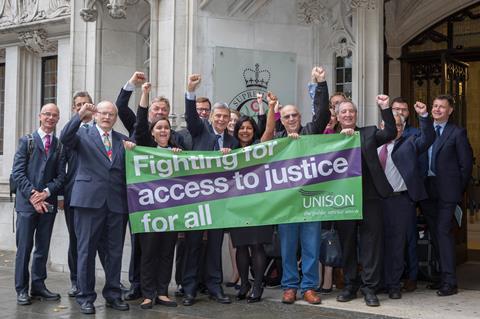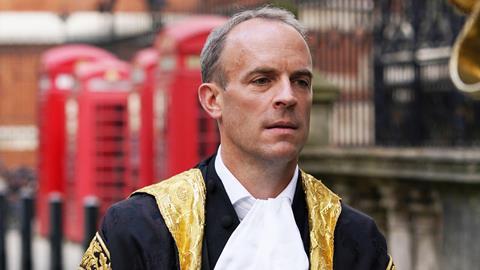Ministers have become fixated on judicial power and the ability of the courts to frustrate government policy. Will they really take on the rule of law as ‘public enemy number one’? Eduardo Reyes reports
The low down
Governments of all political hues naturally dislike losing in court and instinctively kick against the scrutiny involved in the open process of justice. But in recent years, that dislike has been channelled into attacks on the judiciary for meddling in politics, thereby going against ‘the will of the people’. Governments have labelled this ‘judge-made law’ and ministers clearly think the judiciary should ‘stick to its knitting’. Yet judge-made law – also termed ‘judicial legislation’ – is central to the operation of common law and its fabled flexibility. The basis for government intervention may be shaky on legal principle, but it still has the potential – through the Judicial Review Bill and other measures – to unbalance our unwritten constitution.
There is an emerging narrative from government on the law, the courts, and the relationship it has with both. Keeping track of that story is difficult, because the government’s case is only ever loosely defined. It is, though, characterised by a hostility to courts and lawyers. It ranges from a grand narrative that augurs an autocratic overhaul of our unwritten constitution and justice system, to a muffled capitulation to the status quo.
One target is the Human Rights Act (HRA) – and yet a project to repeal or reform the act has defeated seven justice secretaries. For the HRA’s supporters, the odds seem reassuringly stacked against the incumbent, Dominic Raab. Also listed (with little detail attached) are ‘political cases’, the NHS, policing and judicial review. And while the government is comfortable with its enduring poll lead, having a respected lawyer as leader of the opposition has perhaps increased the temptation for Tory backbenchers to attack all things ‘legal’.
In an article published on 17 October, Raab told the Sunday Telegraph that he is considering a ‘mechanism’ to allow the government to introduce ad hoc legislation to ‘correct’ court judgments that ministers believe are ‘incorrect’. This will form part of proposals to reform the Human Rights Act. Areas in his sights include government itself, ‘the NHS… welfare provision… police forces’.
This was followed two days later by comments from the attorney general Suella Braverman, who said it was ‘crucially important that we neither permit, facilitate or encourage judicial review to be used as a political tool by those who have already lost the arguments’.
The judicial overreach that is alleged is very general. Does it, in fact, even display a proper understanding of what ‘judge-made law’ (also known as ‘judicial legislation’) is?
Judge-made law is a central component of a common law system; relevant here is how it relates to civil matters. The Supreme Court’s deputy president, Lord Hodge, described its role and parameters in the modern age in an address to the Max Planck Institute of Comparative and International Private Law, Germany, in 2019.
In a common law system, Hodge noted, judges’ development of the law happens predominantly in the private sphere. While statute law impinges on many areas of private law, judges have a major role in developing the law so that it reflects ‘logic and symmetry’. This keeps the law ‘abreast of social conditions and expectations’.
The ‘law of obligations’, which includes negligence, Hodge observed, ‘is essentially judge-made’.
'If the court gets involved in ruling whether a decision is lawful or not, you can say judges are getting involved in a political issue. That’s a part of the judicial role'
Lord Neuberger, president of the Supreme Court 2012-2017
Judicial legislation
In the public sphere, judicial legislation may reflect gaps in statute that need to be resolved, or a conflict between, for example, subordinate and other legislation. In the absence of a written constitution to define the rights of the citizen, the courts might decide that parts of the tangible legal architecture – such as the HRA – serve that purpose.
There is a ‘judicial duty to determine a dispute’, Hodge said, which may involve applying ‘existing principles in new contexts’. There is a role for ‘wisdom, humanity and common sense’, but ‘disputed areas of social policy are less suitable’ for judge-made law. Judgments in this public sphere are reached within a comprehensive set of ‘restraints’ (see ‘Judicial constraints’).
Although those restraints are real, Hodge observed, ‘there is a boundary to judicial law-making, but there is no consensus on where that is’. In part this reflects the highly prized flexibility of the common law system.
That boundary sometimes involves politics. As Lord Neuberger told the Public Law Project’s annual conference last week: ‘If the court gets involved in ruling whether a decision is lawful or not – a fundamental aspect of the rule of law – you can say judges are getting involved in a political issue. That’s a part of the judicial role.’
Judicial review
Hodge’s definition of judicial legislation and the restraints placed upon it are useful. Not least, it is clear that many judgments that go against the government are down to judges applying, rather than ‘making’, the law.
Hodge makes the point that judgments are ‘defeasible’, in that parliament can legislate in response to a judgment that goes against it. The parliamentary ‘mechanism’ already exists. As Shantha David, Unison’s head of legal, points out: ‘I would say there are no constraints and the mechanism exists.’ She points to the government’s response to cases brought with Unison’s support on the Transfer of Undertakings (Protection of Employment) Regulations (TUPE), which in 2012 was to amend the definition of ‘changes in the workforce’.
‘Historically, [European Court of Human Rights] rulings on healthcare have led to helpful changes in legislation,’ Kingsley Napley partner Sophie Kemp adds. She points to R v Bournewood Community and Mental Health NHS Trust [1999], where the House of Lords ruled that a man who had been readmitted as an inpatient to a psychiatric hospital without capable consent had not been unlawfully detained under the common law. However, a subsequent ECtHR ruling (2004) found that the man had been unlawfully deprived of his liberty in violation of Article 5 of the Convention. ‘In response to this ruling, the Deprivation of Liberty Standards were introduced as part of the Mental Capacity Act 2005 in order to make English law compatible with the [European Convention on Human Rights],’ Kemp notes.
In the UK, the HRA is not quite the trump card its critics would claim. While section 3 of the HRA requires the courts to interpret and apply domestic legislation in a way that is compatible with the rights as set out in the Convention, section 3(2)(b) safeguards parliamentary sovereignty and ensures that parliament may enact legislation that is incompatible with Convention rights.

This provision, says former Law Society president David Greene, senior partner of Edwin Coe, ‘places a significant limitation on the extent to which judges can “make law” in respect of the application of Convention rights to the domestic context’. Greene points out that the House of Lords judgment in Ghaidan v Godin-Mendoza [2004] UKHL 30 ‘recognised the limits on the courts’ powers under section 3 HRA and that parliament had retained the right to enact legislation which is not Convention-compliant. It is really a question of politics – no government wants to be seen to introduce legislation which ignores Convention rights’.
Greene assesses the government’s reform agenda thus: ‘My understanding… is that the government intends to use its majority in parliament to undo a court’s interpretation of statute. I presume this is a reflection of the breathing space that the government proposes in judicial review – time and space in which the relevant authority can correct the errors found by the court. But in this case it would be time for parliament to re-legislate to “correct” the error of the court in its interpretation of statute.’
And on this, the Judicial Review Bill has seen some late-stage additions, notably clauses 1 and 2, which may be Raab’s preferred vehicles for change.
‘Big’ government losses in the courts are often judicial reviews. Clause 1 creates the option for a court to make a winning claimant’s remedy ‘prospective-only’, such that a finding of unlawfulness might not result in remedial action. Together with suspended quashing orders, this gives enhanced weight to executive assurances over other significant evidence.
Clause 2, which could be most closely associated with home secretary Priti Patel’s wish list, severely restricts Cart judicial reviews, which safeguard against errors in the tribunal system, including the immigration and asylum tribunals. Here human rights group Liberty says: ‘Based on faulty statistical reasoning, the reversal of Cart will lead to people who would otherwise have won their cases being deported or made homeless, entirely due to this bill.’
The government’s case for reform may be based on a false prospectus, but Unison’s David reflects that its impact could be far-reaching. She took the union’s winning Employment Tribunal fees case to the Supreme Court, and her assessment of possible reforms is stark: ‘A narrower statutory codification on judicial review could have prevented or deterred the UK Supreme Court from reaching its seminal conclusions on the right of access to justice for Unison on behalf of its members.’
Life and death
When the justice secretary mentions ‘the NHS’, he is perhaps not just thinking of judicial review. It is widely acknowledged that the law of negligence has been largely developed by judges. Within that, clinical negligence is an area of law that has caught the government’s attention.
As chair of the Commons Health and Social Care Committee, former health secretary Jeremy Hunt has echoed government concern over the level of payments made in negligence cases. In a report of July this year, the committee said compensation payments in medical negligence claims were ‘unsustainable’. Hunt followed this up at the end of September, calling the cost of compensation ‘obscene’.
Also in September, the government said it will consult on reforms of clinical negligence. The announcement was light on detail, but if reform serves either to alter the dispute resolution process or the calculation of payments, as recommended by Hunt’s committee, that would be a major incursion into an area of ‘judge-made law’.
‘Medical negligence is a really serious allegation and it requires due process or fairness to both claimant and defendant,’ Irwin Mitchell partner Anne Kavanagh tells the Gazette. ‘I think there are huge justice issues around, for instance, any proposal to separate out medical negligence as a tort from any other tort. Within that, are we to make the NHS a unique tortfeasor?’
The law on assisted death and suicide has also illustrated the ‘contested’ boundary between parliamentary sovereignty and the courts. Once again, the mechanism for testing that boundary has been judicial review.
Lord Neuberger’s 2014 judgment in Nicklinson was widely seen as a shot across parliament’s bows. The court asserted its right to rule that the existing law was incompatible with Tony Nicklinson’s human rights, but did not issue a notice of HRA incompatibility. The matter was for parliament to resolve, but if it did not consider the law within a reasonable timescale, then it was indicated that the court might.
As Kemp explains: ‘In exercising its discretion not to make a declaration, the court in this case allowed parliament to reconsider and amend the offending legislation. Nicklinson highlights declarations of incompatibility as a mechanism for “collaboration” between the courts and parliament.’
Constitutional controls
Lord Hodge ended his 2019 lecture by noting: ‘The fact that judge-made law is an independent source of law contributes to its flexibility. And judges continue to adapt the common law to changes in commercial practice and social values.’
So will judges continue to do so where government policy or actions are concerned?
The justice secretary has said he will publish a consultation on his proposals for a ‘mechanism’ by which judgments can be ‘corrected’ in two months. His plans are being drawn up in the context of deep disquiet at the new clauses 1 and 2 of the Judicial Review Bill, and a declared intention to reform the judge-made laws around medical negligence.
Unison’s David observes: ‘There appears to be an agenda by the government to limit the courts’ existing powers in order to shield public authorities from legal scrutiny on their decisions.’
‘In a fully functioning democracy, governments of every hue should not be afraid of their decisions being challenged within the judicial system,’ she adds. ‘No government or public authority is ever likely to call for greater powers of scrutiny against their decisions, but the power is nevertheless an integral part of the UK’s constitutional controls.’
Judicial constraints
In 2019, Lord Hodge, now the Supreme Court’s deputy president, set out his own thinking on the constraints that should restrain judges. He concluded: ‘Judicial law-making is… constrained law‑making.’
‘The first and perhaps the most significant constraint on most judges is the doctrine of precedent, without which judge-made law could descend into arbitrariness.’ From 1966, the House of Lords was allowed to depart from its own precedents. By 2009, it had done so 25 times. The Supreme Court retained this freedom upon its establishment that year.
‘The declaratory theory of the common law, namely that a judicial decision, even when it is in reality innovative, is stating what the law has always been.’

‘The general recognition that, when faced with circumstances which are not governed by established rules, a judge is to search for and apply a principle.’
Role recognition. ‘This is sometimes called “judicial restraint” but I will stick with my preferred expression, because it points to an objective constraint rather than mere judicial self-denial. It has also been referred to as the “separation of powers”, but that expression begs the question because it does not identify the boundary of the judicial power.’
‘A reluctance to develop the common law in ways which have serious consequences for public expenditure.’
‘The legislative sovereignty of parliament… Judges recognise that they are not permitted to develop the law in a direction which is contrary to the expressed will of parliament. They may fill in gaps left by parliament but must not create incongruity.’



































No comments yet